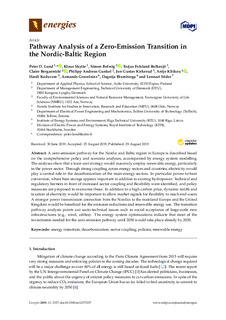Pathway analysis of a zero-emission transition in the Nordic-Baltic region
Lund, Peter D.; Skytte, Klaus; Bolwig, Simon; Bolkesjø, Torjus Folsland; Bergaentzlé, Claire; Gunkel, Philipp Andreas; Kirkerud, Jon Gustav; Klitkou, Antje; Koduvere, Hardi; Gravelsinš, Armands; Blumberga, Dagnija; Söder, Lennart
Journal article, Peer reviewed
Published version

Åpne
Permanent lenke
http://hdl.handle.net/11250/2611893Utgivelsesdato
2019-08-29Metadata
Vis full innførselSamlinger
Originalversjon
Lund, P. D., Skytte, K., Bolwig, S., Bolkesjø, T. F., Bergaentzlé, C., Gunkel, P. A., Kirkerud, J. G., Klitkou, A., Koduvere, H., Gravelsinš, A., Blumberga, D. & Söder, L. (2019). Pathway analysis of a zero-emission transition in the Nordic-Baltic region. Energies, 12(7), 1-20. 10.3390/en12173337Sammendrag
A zero-emission pathway for the Nordic and Baltic region in Europe is described based on the comprehensive policy and scenario analyses, accompanied by energy system modelling. The analyses show that a least-cost strategy would massively employ renewable energy, particularly in the power sector. Through strong coupling across energy sectors and countries, electricity would play a central role in the decarbonization of the main energy sectors. In particular power-to-heat conversion, where heat storage appears important in addition to existing hydropower. Technical and regulatory barriers in front of increased sector coupling and flexibility were identified, and policy measures are proposed to overcome these. In addition to a high carbon price, dynamic tariffs and taxation of electricity would be important to allow market signals for flexibility to reach end-users. A stronger power transmission connection from the Nordics to the mainland-Europe and the United Kingdom would be beneficial for the emission reductions and renewable energy use. The transition pathway analysis points out socio-technical issues such as social acceptance of large-scale new infrastructures (e.g., wind, cables). The energy system optimizations indicate that most of the investments needed for the zero-emission pathway until 2050 would take place already by 2030.
